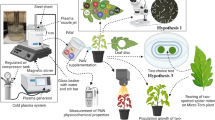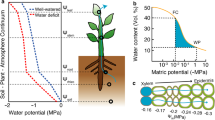Abstract
Symptoms of boron toxicity (i.e., necrosis of leaf tips and margins) have been observed on eucalyptus trees in the San Joaquin Valley of California where the trees are being tested for their effectiveness at reducing the volume of agricultural drainage effluents. In a controlled, outdoor sand-tank study, Eucalyptus camaldulensis Dehn., Clone 4544 trees were grown and irrigated with combinations of salinity and B to determine their influence on tree growth and water use. Irrigation water quality treatments were prepared to simulate the Na-sulfate salinity, high B nature of these drainage effluents. Electrical conductivities (ECiw) of the waters ranged from 2 to 28 dS m-1 and B concentrations ranging from 1 to 30 mg L-1. As an integral component of this study , we developed a method to quantify and correlate foliar damage with leaf B concentrations. By scanning both injured and uninjured leaves into computer files and processing with image analysis, we were able to simultaneously correlate salinity stress with its overall effect on leaf area as well as to quantify the relative fraction of leaf area affected by specific-ion (i.e., B) injury. Leaf area was unaffected by B stress but was reduced by salinity only in the younger leaves. Boron injury was correlated with increasing irrigation water B only in older leaves. The relative injured area (RIA) of the older leaves was related to the B concentrations of leaves from trees grown at various salinities . A regression equation was developed from injury data obtained from trees grown under boron and salinity stress for 223 days (r2=0.90). From this relationship, we were able to estimate leaf boron concentrations from injury symptoms in leaves selected at random from main trunk branches of trees grown for 333 days under the same stress conditions. The results suggest that this method may have potential as an effective tool for monitoring the response to toxic levels of boron in eucalyptus, once B toxicity has been established by analytical means. The RIA appears to be mitigated by increased salinity of the irrigation water and is consistent with the general reduction in leaf B by salinity. The interactive effects of boron and salinity on foliar injury depends on the physiological age of the leaf.
Similar content being viewed by others
References
Ashworth L J Jr, Gaona S A and Surber E 1985 Nutritional diseases of pistachio trees: Potassium and phosphorus deficiencies and chloride and boron toxicities. Phytopath. 75, 1084–1091.
Bernstein L and Hayward H E 1958 Physiology of salt tolerance. Annu. Rev. Plant. Physiol. 9, 25–46.
Bernstein L and Pearson G A 1954 Influence of integrated moisture stress achieved by varying the osmotic pressure of culture solutions on growth of tomato and pepper plants. Soil Sci. 77, 355–368.
Brown P H and Shelp B J 1997 Boron mobility in plants. Plant Soil 193, 85–101.
Cervinka V 1994 Agroforestry farming system for the management of selenium and salt on irrigated farmland. In Eds. Selenium in the Environment. J R Frankenberger and S Benson pp. 237–250. Marcel Dekker Inc. New York.
Dell B 1996 Diagnosis of nutrient deficiencies in eucalypts. pp. 417–440. In Nutrition of Eucalypts. 1996. Eds. P M Attiwill and Mark A Adams. CSIRO, Collingwood Vic. Australia.
El-Motaium R, Hening H and Brown P H 1994 The relative tolerance of six Prunus rootstocks to boron and salinity. J. Amer. Soc. Hort. Sci. 119(6), 1169–1175.
Grattan S R, Shannon M C, Grieve C M, Poss J A, Suarez D and Francois, L 1996 Interactive effects of salinity and boron on the performance and water use of eucalyptus. Acta Horticulturae 449(2), 607–613.
Handreck K A 1990 Methods of assessing boron availability in potting media with special reference to toxicity. Comm. In Soil Sci. Plant Anal. 21, 2265–2280.
Lamb D 1976 Variations in the foliar concentrations of macro and micro elements in a fast-growing tropical eucalypt. Plant Soil 45, 477–492.
Maas E V and Nieman R H 1978 Physiology of plant tolerance to salinity. In Crop Tolerance to Suboptimal Land Conditions. Ed. G A Jung. pp 277–299. ASA Special Publication. Madison, Wisconsin.
Mallows, C L 1964 Some comments on Cp. Technometrics 15, 661–675.
Marcar N and Crawford D 1996 Tree-growing strategies for the productive use of saline land. Aust. Jour. of Soil and Water Conservation 9(3), 34–40.
Oertli J J 1993 The mobility of boron in plants. Plant Soil 155/156, 301–304.
San Joaquin Valley Drainage Program. 1990 A management plan for agricultural subsurface drainage and related problems on the westside San Joaquin Valley. Final report by the US Dept. of Interior (BOR, FWS, GS) and California Resources Agencies (DWR, F and G). E. Imhoff, Program Manager, Sacramento, CA. 183 pp.
SAS Institute. 1985 Proc GLM, Proc RSREG, Proc STEPWISE. SAS User's Guide: Statistics. Version 5 ed. SAS Inst., Inc., Cary, NC.
van Genuchten M Th and Hoffman G J 1984 Analysis of crop salt tolerance data. In: Soil Salinity Under Irrigation: Process and Management. Ecological Studies 51. Eds. I. Shainberg and J. Shalhevet pp. 258–271. Springer-Verlag, New York.
Vike E and Håbjørg A 1995 Variation in fluoride content and leaf injury on plants associated with three aluminium smelters in Norway. Science of Total Environment 163, 25–34.
Winsor G 1987 Diagnosis of mineral disorders in plants. In Glasshouse Crops. Geoffrey Winsor and Peter Adams; new photographs by Peter Fiske and Andrew Smith; General Editor J B O Robinson. HMSO, London.
Yadav H D, Yadav O P, Dhankar O P and Oswal M C 1989 Effect of chloride salinity and boron on germination, growth, and mineral composition of chickpea (Cicer arietinum, L.) Annals Arid Zone, 28, 63–67.
Author information
Authors and Affiliations
Rights and permissions
About this article
Cite this article
Poss, J., Grattan, S., Grieve, C. et al. Characterization of leaf boron injury in salt-stressed Eucalyptus by image analysis. Plant Soil 206, 237–245 (1999). https://doi.org/10.1023/A:1004488331737
Issue Date:
DOI: https://doi.org/10.1023/A:1004488331737




